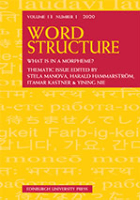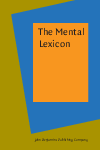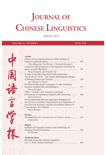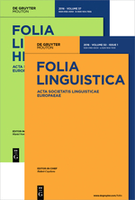
Word Structure
Scope & Guideline
Innovating Understanding in Language Structures
Introduction
Aims and Scopes
- Morphological Analysis and Theoretical Frameworks:
The journal emphasizes the exploration of morphological structures and their theoretical implications, often employing both qualitative and quantitative methodologies to analyze word formation processes. - Cross-Linguistic Studies:
A consistent focus on comparative studies across languages allows for the examination of morphological phenomena such as agreement, inflection, and derivation in diverse linguistic contexts. - Empirical Research Using Corpora:
The journal showcases a strong commitment to empirical research, utilizing language corpora to derive insights about morphological patterns and usage in real-world language data. - Acquisition and Processing of Morphology:
Research often delves into how morphological knowledge is acquired, processed, and represented in the mind, including studies on language development and cognitive aspects of morphology. - Morphological Variation and Change:
The journal addresses issues of morphological variation and the effects of language contact, typological change, and sociolinguistic factors on morphological systems.
Trending and Emerging
- Corpus-Based Morphological Studies:
There is a marked increase in studies utilizing corpus data to analyze morphological patterns, reflecting a growing trend towards empirical methodologies that provide robust insights into language use. - Morphological Rivalry and Competition:
Emerging research focuses on the dynamics of morphological rivalry, including affix competition and the impact of linguistic and non-linguistic factors, which indicates a deeper exploration of how morphological elements interact. - The Intersection of Morphology and Syntax:
Recent papers have emphasized the relationship between morphology and syntax, particularly in the context of agreement systems, signaling a trend towards interdisciplinary approaches that bridge different areas of linguistics. - Language Contact and Morphological Change:
Research examining the effects of language contact on morphological structures is increasing, highlighting the relevance of sociolinguistic factors and typological changes in contemporary morphological studies. - Acquisition of Complex Morphological Systems:
A growing interest in how complex morphological systems are acquired, particularly in languages with rich inflectional paradigms, indicates a trend towards understanding the cognitive aspects of morphology.
Declining or Waning
- Traditional Morphological Descriptions:
Papers focusing solely on traditional morphological descriptions without empirical support or innovative theoretical perspectives have become less common, indicating a shift towards more data-driven and analytical approaches. - Historical Morphology Studies:
Research centered on historical or diachronic aspects of morphology has shown a decline, possibly due to a growing preference for synchronic studies that provide immediate relevance to current linguistic practices. - Exclusively Theoretical Contributions Without Empirical Data:
There is a noticeable decrease in purely theoretical discussions lacking empirical backing, suggesting a trend towards integrating theoretical frameworks with real-world data.
Similar Journals

Brills Annual of Afroasiatic Languages and Linguistics
Illuminating the Diversity of Afroasiatic LanguagesBrill's Annual of Afroasiatic Languages and Linguistics stands as a vital publication in the field of linguistics, specifically focusing on the rich and diverse Afroasiatic language family. Published by the esteemed BRILL, this journal has garnered a reputation for rigorous scholarship since its inception in 2009, converging into its current publication cycle through to 2024. With an ISSN of 1876-6633 and an E-ISSN of 1877-6930, it enjoys a commendable Category Quartile ranking of Q2 in Linguistics and Language for 2023 and respectable Scopus rankings in both Arts and Humanities and Social Sciences. This journal aims to provide a platform for researchers, educators, and students alike, facilitating the dissemination of innovative research, critical analyses, and theoretical advancements within the Afroasiatic linguistic domain. Given its substantial engagement with contemporary linguistics, this annual publication is invaluable for those aiming to deepen their understanding of languages and dialects across the Afroasiatic spectrum.

Mental Lexicon
Advancing Research in Cognitive LinguisticsMental Lexicon is a leading academic journal published by JOHN BENJAMINS PUBLISHING CO that spans significant interdisciplinary terrains including Cognitive Neuroscience and Linguistics. Since its inception in 2006, the journal has gained a prestigious reputation, currently holding a Q1 tier in Linguistics and Language and a Q3 rating in Cognitive Neuroscience based on 2023 categorizations. With impressive Scopus rankings—247 out of 1088 in Language and Linguistics and 94 out of 115 in Cognitive Neuroscience—it serves as a critical platform for the dissemination of innovative research and theoretical advancements in mental lexicon studies. The journal fosters an environment for scholars, researchers, and students to explore the complexities of language processing and cognitive functions, thereby contributing to the realization of our understanding of the mind and language. While Mental Lexicon operates under closed access, it remains an essential resource for those seeking to delve into the intricate relationship between linguistic capabilities and cognitive processes.

Turkic Languages
Exploring the Rich Tapestry of Turkic LinguisticsTurkic Languages is an esteemed academic journal published by HARRASSOWITZ VERLAG, dedicated to the exploration and analysis of Turkic languages within the broader fields of linguistics and language studies. With an ISSN of 1431-4983, this journal serves as a vital platform for researchers, professionals, and students interested in the intricate structures, dynamics, and cultural contexts of Turkic languages. Although it currently operates without an Open Access option, the journal's commitment to quality research is evident in its placement within the Q4 category of Linguistics and Language for 2023, alongside its Scopus rankings where it stands in the 30th and 26th percentiles for Language and Linguistics across Arts and Humanities and Social Sciences, respectively. The journal's scope encompasses a variety of linguistic phenomena, striving to foster a deeper understanding of Turkic languages and their significance in the global linguistic landscape. With converged years from 2017 to 2022, Turkic Languages continues to uphold its reputation as a crucial resource for advancing scholarship in this specialized field.

JOURNAL OF CHINESE LINGUISTICS
Exploring Linguistic Diversity Through a Chinese LensJOURNAL OF CHINESE LINGUISTICS, published by the JOURNAL CHINESE LINGUISTICS, is a prominent periodical that serves as a vital resource for researchers and scholars in the fields of linguistics and Chinese studies. With its ISSN 0091-3723, this journal has been contributing to the academic community since 1996 and continues to publish innovative research until 2024. Although it is classified in the third quartile (Q3) for both Arts and Humanities and Linguistics categories, its focus on Chinese linguistics positions it uniquely within this specialized domain. The journal is committed to advancing the understanding of Chinese language structures, usage, and context, encouraging interdisciplinary dialogue among linguists and language researchers. While currently not labeled as open access, the journal remains accessible to institutions and scholars worldwide, creating an invaluable platform for disseminating knowledge. As such, it plays a critical role in promoting linguistic diversity and cultural awareness within the academic landscape.

Syntax-A Journal of Theoretical Experimental and Interdisciplinary Research
Elevating Linguistic Scholarship to New HeightsSyntax - A Journal of Theoretical Experimental and Interdisciplinary Research is a premier journal dedicated to advancing the field of linguistics, serving as a platform for high-quality research that spans theoretical, experimental, and interdisciplinary dimensions. Published by Wiley and located in the United Kingdom, this journal holds a prestigious Q1 ranking in the Linguistics and Language category as of 2023, highlighting its significance and impact within the academic community. With an impressive Scopus ranking of Rank #204/1088 in Arts and Humanities and Rank #239/1167 in Social Sciences, the journal occupies an influential position among leading publications, appealing to researchers, professionals, and students alike. Syntax encourages innovative studies that contribute to our understanding of language structure and use, making it an essential read for anyone invested in linguistic research. Although the journal is not Open Access, its commitment to rigorous scholarship ensures that it remains a vital resource for those exploring cutting-edge theories and empirical findings in the dynamic field of linguistics.

Lingue e Linguaggio
Connecting Scholars in the Realm of Language and LinguisticsLingue e Linguaggio, published by SOC ED IL MULINO, is a distinguished academic journal in the field of Linguistics and Language, hailing from Bologna, Italy. With an esteemed Q2 ranking in its category as of 2023, this journal is recognized for its contributions to both the arts and humanities as well as social sciences, achieving notable positions within Scopus rankings. It serves as a vital platform for researchers, practitioners, and students interested in exploring various linguistic phenomena, language dynamics, and theoretical frameworks. Although it operates under a traditional subscription model rather than open access, its comprehensive array of studies and publications provides significant insights and fosters academic discourse. With a publication period extending from 2002 to 2024, Lingue e Linguaggio continues to be a key resource for advancing the understanding of language in contemporary contexts.

Dialectologia
Exploring the Rich Tapestry of Language VariationDialectologia, published by the Universidad de Barcelona, Facultad de Filología, is a distinguished academic journal dedicated to the fields of linguistics and language studies. Since its inception in 2008, this Open Access journal has made significant strides in disseminating knowledge, fostering scholarly communication, and promoting research in dialectology and sociolinguistics. With its current classification in the Q3 quartile of linguistics and language, and Scopus rankings placing it in the 32nd and 29th percentiles within the Arts and Humanities and Social Sciences, respectively, Dialectologia plays a crucial role in advancing the study of language variation and change. The journal’s commitment to providing a platform for innovative research is underscored by its accessibility to a wide audience, ensuring that researchers, professionals, and students alike can engage with and contribute to contemporary discourse in language studies. Based in Barcelona, Spain, Dialectologia not only enriches academic literature but also connects a global community of language scholars through its compelling and diverse contributions.

FOLIA LINGUISTICA
Advancing Linguistic Knowledge Since 1967FOLIA LINGUISTICA, published by WALTER DE GRUYTER GMBH, is a premier scholarly journal dedicated to the field of linguistics. Established in 1967, the journal has consistently provided a platform for innovative research and scholarly discourse in language and linguistics, contributing significantly to the academic community's understanding of language structures, usage, and cognitive processes. With its classification in the top quartile (Q1) of linguistics and language in 2023, FOLIA LINGUISTICA holds a respectable rank (#282/1088) within the Arts and Humanities category and an admirable percentile rank of 74th, ensuring its position at the forefront of linguistic scholarship. Researchers and academics from around the globe can access a wealth of knowledge and cutting-edge research findings through this esteemed publication, which is vital for anyone looking to engage with the latest advancements in linguistics. Located in Berlin, Germany, FOLIA LINGUISTICA encompasses all aspects of language research, making it an indispensable resource for researchers, professionals, and students alike seeking to deepen their understanding of language and its complexities.

SKASE Journal of Theoretical Linguistics
Bridging Heritage and Modernity in Linguistic ScholarshipSKASE Journal of Theoretical Linguistics, published by the SLOVAK ASSOCIATION STUDY ENGLISH-SKASE, is a distinguished Open Access journal that expands the horizons of linguistic research and theoretical frameworks. With its ISSN N/A and E-ISSN 1336-782X, the journal has established itself as a pivotal resource for scholars in the field, achieving a commendable Q2 ranking in Linguistics and Language as of 2023. The journal, which has been in continuous publication since 2017, actively publishes innovative research studies, reviews, and theoretical discussions, easing access to groundbreaking work for academics and practitioners alike. Based in Slovakia, it connects a rich heritage of linguistic scholarship and is indexed in Scopus, ranking alongside its peers in both Arts and Humanities and Social Sciences categories. The SKASE Journal of Theoretical Linguistics is crucial for anyone interested in the evolving landscapes of linguistics, serving as an invaluable platform for disseminating knowledge and fostering collaboration amongst researchers worldwide.

Journal of Greek Linguistics
Advancing the Legacy of Greek LinguisticsThe Journal of Greek Linguistics, published by BRILL, is a premier platform dedicated to advancing the study of Greek language and its historical and contemporary implications within the broader field of linguistics. With an impact factor recognized in the linguistics community, this journal significantly contributes to the academic discourse surrounding Greek linguistics and its relevance in cultural and social studies. First made open access in 2016, it is now accessible to a global audience, facilitating a collaborative environment for researchers, scholars, professionals, and students alike. The journal is proudly positioned in the Q2 quartile for linguistics and language, reflecting its esteemed standing in the academic community, and it ranks within the top 30% in both the Arts and Humanities and Social Sciences categories according to Scopus. With a focus on the intersection of language, culture, and society, the journal invites contributions that offer new insights and promote interdisciplinary research. The Journal of Greek Linguistics continues to be an essential resource for those engaged in the rich and evolving conversation about the Greek language.